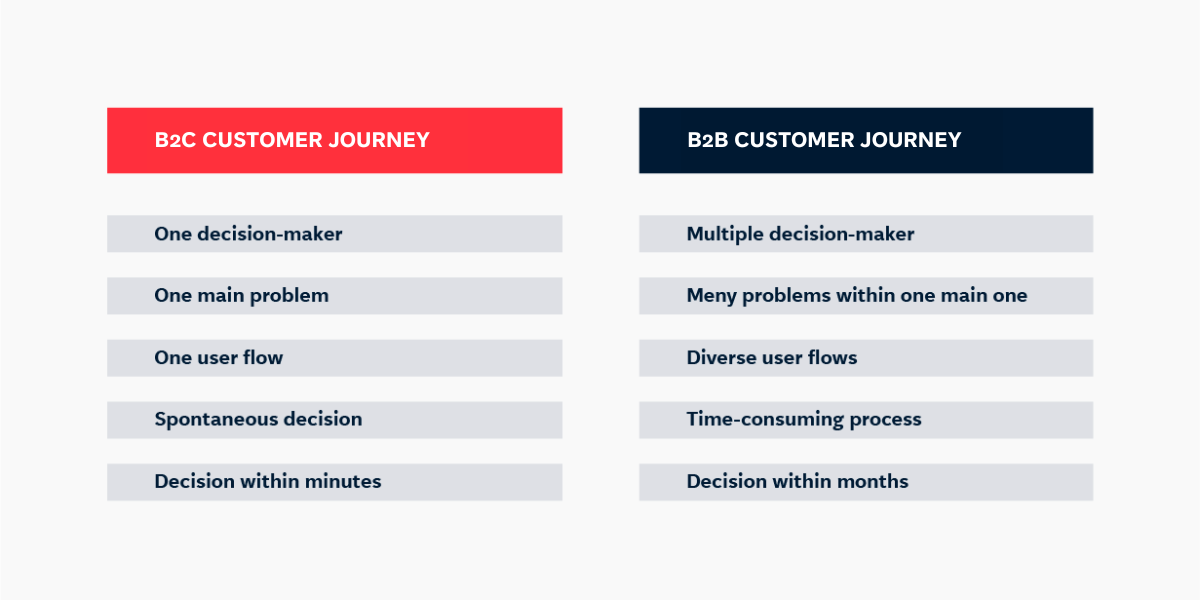How to create an effective B2B customer journey map
December 7, 2021 / 7 min read

Table of contents
Mapping a customer journey in the B2B world is as profitable as it is challenging. The process can be complicated and time-consuming with several departments involved. Yet mapping a customer journey is no doubt beneficial for your company. It allows you to close more deals and reach new clients more efficiently.
In this article, we will show you a simple but effective approach to customer journey mapping. What should you pay attention to and what are the differences between B2B and B2C? Let's find out and take a look at some customer journey mapping examples!
Before we get down to specifics, let’s talk about customer journey map basics. What is it and what is it used for?
What is a customer journey map?
Generally speaking, a customer journey describes complex interaction with a brand/product, typically showcased graphically in the form of an infographic or a flowchart. Mapping a customer journey allows you to describe and understand how potential clients become aware of your brand and its offer and decide to place an order.
A B2B customer journey map ought to show all interactions and touchpoints that take place between the brand and the client before, during and after a transaction. It also allows you to reach more clients and understand their problems and needs.
Before you start working on a B2B customer journey map, you should take care of two other things:
- Buyer personas
- A list of touchpoints and communication channels (social media, ads, leaflets, physical stores, etc.)
We’ll get to that in a few moments.
What are the benefits of a B2B customer journey map?
People who buy a product or service are usually unaware of what stage of the customer journey they are at. But they are well aware of the factors that discourage them from purchasing. A customer journey mapping helps brands to identify these critical elements and avoid them.
A customer journey mapping also enables your company to:
- Deliver desirable and streamlined products and services
- Tailor your products and services to your clients’ needs
- Understand your customer standpoint (their experiences and even their feelings) better and see how it’s changing during the journey
- Develop compelling offers
In brief, we could say that the whole purpose of a customer journey mapping is to focus your attention on your clients. A B2B customer journey map places the customer's experience at the very centre of how your company looks and works.
What is the difference between B2B and B2C customer journey mappings?
In 2018, DemandGen[1] published a report stating that B2B buying cycles last one to three months and involve up to six people. Things are much simpler and quicker in the B2C world, as the products are designed for the consumers' personal benefit. And customers usually have an idea of what they need or want to buy, right? The majority of individual customers make a decision in minutes or even seconds.
What other differences should you be aware of?
The process of creating a journey map for a B2B client
START WITH A BUYER PERSONA
Many marketers associate buyer personas primarily with the B2C environment. That’s a huge mistake. Even though it’s true that B2B companies communicate and sell to other companies, there are still people on both sides of the table. It is people who place, order and sign agreements. That’s why you should create buyer personas – to understand your clients better.
Shortly put, the buyer persona is a profile of your perfect or typical client. It consists of several elements, such as:
- Position in the company
- Department they work in
- Behaviours
- Motivators
- Needs
- Challenges
- Objections
Remember that it’s critical to base personas on real insights gathered during research, not on your own vision of the buyer. Typically, companies or marketing agencies create a graphic visualisation of such a buyer persona. Something like this:

A buyer persona allows you to understand who your clients really are. What are their pain points and challenges? Creating a buyer persona is an attempt to get into your clients' shoes. It allows you to analyse their everyday work and understand why they do what they do and buy what they buy. When your buyer persona is ready, you can turn your attention to touchpoints.
TOUCHPOINTS IN A CUSTOMER JOURNEY
Touchpoints are essential in every customer journey mapping. They include all the places and channels your clients use to discover and communicate with your company. B2B touchpoints are moments of interaction between users and the brand via channels such as your:
- Website
- Blog
- Ads
- Social media profiles
- Newsletters
Your customer journey map should include all of these places and channels. This way, you can easily assess which are the most important in the purchasing process, what role they play and at what stage. Typically, companies divide touchpoints into three main categories:
- Before placing an order
- During the purchasing process
- After completing the transaction
When creating these contact points for your B2B customer journey map, it is worth selecting those that are particularly important from the seller's point of view. If you have created a buyer persona, use it now. With this approach, you can define your clients' expectations and motivations for each point of contact.
WHAT IS THE DIFFERENCE BETWEEN A CUSTOMER JOURNEY MAP AND A SALES FUNNEL?
Although both customer journey maps and sales funnels illustrate how a lead becomes a client, the marketing funnel determines the shortest path a client can take from brand awareness to purchase.
In real life, things are not that simple. The path a lead follows to become a client is often complex and time-consuming. According to Gartner[2]:
- 77% of B2B buyers feel that making a purchase is very complicated and time-consuming,
- 90% of survey customers do not follow a straightforward customer journey, often looping back and repeating at least one or more tasks in the buyer journey.
The goal of B2B customer journey maps is to understand how your target audience learns about your business, what interests it, when and why it decides to make a purchase. You could say that the customer journey is a more detailed description of the sales funnel. It also involves the customers' personalities, emotional states, and communication preferences.

CUSTOMER JOURNEY MAPPING EXAMPLES
Be aware that there are no customer journey mapping templates to follow. Best practices differ depending on the company, industry, product or service being mapped. However, based on this guide and the steps described in it, you can create your own B2B customer journey map. There are many models you can incorporate in customer journey mapping.
The linear model[3] is the most popular. It divides the customer journey map into five stages: Awareness, consideration, purchase, service/retention and loyalty/advocacy. Here’s what it can look like:

Other models are, for instance:
- Tactical customer journey map: This model concentrates on a particular touchpoint (or set of touchpoints) to highlight the journey at that particular stage.
- Performance and improvement customer journey map: This model goes into more detail than the tactical journey map. It revolves around the performance at each step of the purchasing process, along with key recommendations at each stage.
However, as Gartner’s research and our experience show, the linear model is not always sufficient. A B2B customer journey is usually not linear, although it consists of several repetitive stages:
- Problem identification: When the company decides, “We need to do something with our problem.”
- Solution exploration “How can we solve our problem? What solutions are available in the market?”
- Requirements building “What do we expect from the contractor? What requirements need to be fulfilled?”
- Supplier selection “Which company can help us?”
- Validation “Is this really the best way to solve our problem?”
- Consensus creation “We’re ready to place an order!”
Seems pretty straightforward, correct? In theory, it is. In practice, it may look more like this:

That's why we say that B2B customer journey mapping is such a complex and time-consuming endeavour. You have to take all these elements into account. These six elements must happen at least once in order to finalise a purchase successfully, but they can occur simultaneously or even out of order. For instance, never assume that the supplier selection has to happen after building the list of requirements.
GETTING TO THE POINT – DESIGN YOUR OWN CUSTOMER JOURNEY MAPPING TEMPLATE
Suppose you already have B2B customer journey touchpoints and personas in place. What should you do next? Generally speaking, you would focus on dividing target groups into specific segments. Most likely, each of these segments will require a separate customer journey map. Include elements such as the segment's:
- Characteristics (location, company size, number of employees, etc.)
- Needs (what they are looking for, what products/services can solve their problems, etc.)
Now, combine that with the touchpoints. Detail all touchpoints from end to end. If possible, add information about UX – customer journey mapping UX is a great way to improve your maps. UX plays a vital role in everything you do, sales or marketing-related. It should be an integral point of each map you create.
How can all of this be done? Usually, companies engage all the stakeholders in the process and ask them for their input. You should also conduct workshops, staff interviews, in-depth interviews (IDIs) etc., to make sure everything important is included.
Workshops help you to:
- Establish a high-level view of your B2B customer journey, see the big picture
- Start thinking about the customer journey and its stages from your client’s perspective
Thanks to staff interviews, you can:
- Validate the first version of the customer journey template
- Add more touchpoints and describe them more thoroughly
- Understand challenges at each stage and touchpoint
And thanks to IDIs, you can:
- Understand your client’s challenges and pain points
- Find potential gaps in your thinking
- Validate the final version of the customer journey map
Tools to help you with this task
If you’ve never created a B2B customer journey map template, you might feel overwhelmed with the information in this article. That’s completely natural. Luckily there are plenty of tools and Saas products to help you get everything in place. Here’s a list you may find useful:
- Smaply.com: This service allows you to design journey maps, personas and stakeholder maps.
- Uxpressia.com: This is a similar tool that comes with almost the same features. Its so-called impact maps, helping you to decide which features to include in a product or service.
- Lucidchart.com: An all-in-one platform allowing you to diagram personas, processes and systems in your company.
All these platforms come with a free basic plan, which is usually sufficient for an SME. However, suppose your company operates with several target groups and has an extensive list of products and services. In that case, it's usually best to outsource the process of creating a B2B customer journey map.
Our role at NoA Ignite is to help you design customer journey maps from scratch. We will take a thorough and objective look at your company and use all the tools we need to develop detailed information about your clients and their challenges.
As a result, you will understand your clients better. This will enable you to reach them more effectively and offer an enhanced user experience. Your new customer journey map will also be an excellent starting point for a content marketing and SEO strategy.
Author

Szymon Heliosz
Senior UX Designer & Customer Experience Strategist
Szymon is our man with a plan. His extensive 15-year experience in UX design, business strategy, and client development means he’s more than earned his stripes in leading and shaping user-centric strategies. Far from being a dictator, Szymon excels by connecting the dots between stakeholders. His ability to facilitate insightful interviews means he delivers what your business needs, not what you think it needs.
Related articles
![A well-crafted prompt doesn’t just work once. It works across teams, channels, and campaigns. It can be tweaked for new use cases and refined based on what performs best.]()
June 27, 2025 / 4 min read
Prompts are marketing assets: how to reuse, and scale them
Prompts aren’t throwaway lines. They’re repeatable, scalable assets that can streamline your marketing your team’s output. Learn how to build a prompt library that delivers.
![Woman using a wheelchair in the office settings]()
June 17, 2025 / 5 min read
What is accessibility and why it matters?
Accessibility ensures everyone — including those with disabilities or limitations — can read, navigate, and engage with your content equally.



